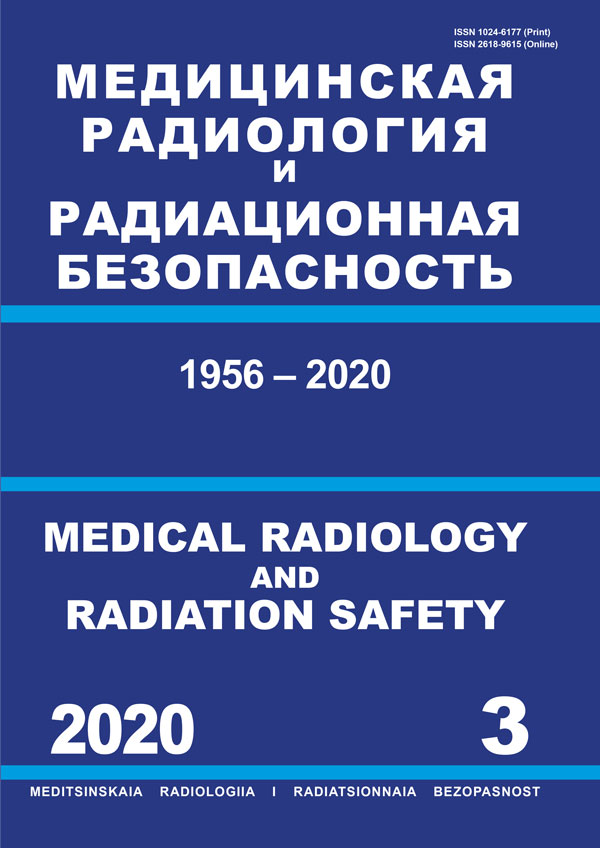Russian Federation
VAC 05.26.05 Ядерная и радиационная безопасность
VAC 14.01.2000 Клиническая медицина
UDK 61 Медицина. Охрана здоровья
GRNTI 76.13 Медицинская техника
OKSO 31.08.05 Клиническая лабораторная диагностика
OKSO 31.08.08 Радиология
BBK 53 Клиническая медицина в целом
BBK 56 Клиническая медицина
BBK 57 Клиническая медицина
TBK 5734 Медицинская радиология и рентгенология
BISAC MED080000 Radiology, Radiotherapy & Nuclear Medicine
In this lecture, the need of using X-ray computed tomography (CT) to assess the intrathyroidal iodine concentration and its storage in the thyroid gland has being discussed. Due to the fact that 80 % of intrathyroidal iodine is located in the phenolic ring of thyroid hormones, which are structurally located in colloid-thyroglobulin follicles as a hormonal depot, the parameter of intrathyroidal iodine (PII) is an indicator of the stores of iodine-containing thyroid hormones directly in the organ. A decrease in intrathyroidal iodine indicates a significant functional impairment of storing thyroid hormones in the colloid of thyroglobulin of the thyroid follicles and is an early highly accurate prognostic sign of the formation of gland dysfunction. Due to the compensatory capabilities of the body, this dysfunction may appear late onset (for example, 2 months after detecting a decrease in intrathyroidal iodine). The most convenient and affordable method for determining intrathyroidal iodine is CT with two types of tomographs: 1) standard by which intrathyroidal iodine is determined by the density of the thyroid gland in Hounsfield units (HU); 2) tomographs with the option of assessing the concentration of intrathyroidal iodine (CII) in the most common units of measurement – mg/g or μg/g (used since 2016). If necessary, the conversion of some units of intrathyroidal iodine to others has the formula: CII (in μg/g) = ([density in HU] – 65) / 104. Based on the literature and our own research results, for the first time, we calculated the limits of normal intrathyroidal iodine fluctuations in euthyroid individuals, which are 85–140 HU units or 200–700 μg/g intrathyroidal iodine. Identification of the examined intrathyroidal iodine beyond the indicated fluctuations indicates the functional impairment of storing thyroid hormones, which ultimately will lead to hypothyroidism or hyperthyroidism (except when the patient is taking levothyroxine, mercazole, β-blockers – drugs that reduce intrathyroidal iodine). For the first time, an algorithm is presented for differential diagnosis of iodine-deficient and iodine-induced thyroid dysfunctions, which can only be done using CT: if there is a functional impairment of the thyroid gland with intrathyroidal iodinelevel less than 85 units of HU or 200 μg/g CII, then it is considered iodine deficient; with intrathyroidal iodinelevel more than 140 units of HU or 700 μg/g of CII, it is considered iodine-induced. The algorithm for the prevention of iodine-induced thyroid pathology with iodine prophylaxis is that iodine prophylaxis should not be prescribed or continued when intrathyroidal iodinelevel is 140 units of HU or 700 μg/g of CII or more.
iodine, thyroid gland, hormone genesis, СТ
1. Tomashevskiy IO, Kouzovlev OP, Zarkov KA, et al. Thyroid Function Estimation via Intrathyroid Iodine Concentrations. Medical Radiology and Radiation Safety. 2007;52(3):25-32. (In Russ.).
2. Tomashevskiy IO, Koloskov SA, Mitoian MR, et al. X-ray Fluorescent Analysis of Intrathyroid Stable Iodine in the Estimation of Thyroid Function. Medical Radiology and Radiation Safety. 2007; 52(4):28-34. (In Russ.).
3. Sargar R, Kurnikova IA, Tomashevskiy IO, Mavlyavieva ER. X-ray Computed Tomography in the Evaluation of Intrathyroid Hormone Formation in Diseases of the Thyroid Gland. J Diabetes Res Endocrinol. 2017;1(2):21.
4. Sargar R, Kurnikova IA, Tomashevskiy IO. Differential Diagnosis Between Iodine-Induced Hyperthyroidism and non Iodine-Iinduced Hyperthyroidism with Computed Tomography. J Clin Mol Endocrinol. 2018;3:35-6.
5. Sargar R, Kurnikova I, Tomashevskiy I. Determination of the Thyroid Gland Density in the Differential Diagnosis of Functional Disorders in Patients with Autoimmune Thyroiditis. Acta Sci Medical Sci. 2019;3(12):23-6.
6. Imanishi Y, Ehara N, Mori J, et al. Measurment of Thyroid Iodine by CT. . J Comput Assist Tomogr. 1991;15(2):287-90.
7. Ishibashi N, Maebayashyi T, Aizawa S, et al. Computed Tomography Density Change in the Thyroid Gland before and after Radiation Therapy. Anticancer Research. 2018(38):417-21.
8. Kamijo K. Clinical Studies on Thyroid CT Number in Chronic Thyroiditis. Endocrine J. 1994;41(1):19-23.
9. Lee GS, Patton JA, Brill AB. Serial Thyroid Iodine Content in Hyperthyroid Patients Treated with Radioiodine. J Nucl Med. 1978;19(6):742.
10. Milakovic M, Berg G, Eggertsen R, et al. Determination of Intrathyroidal Iodine by X-ray Fluorescence Analysis in 60 - to 65-year Olds Living in an Iodine-Sufficient Area. J Internal Med. 2006;260:69-75.
11. Pandey V, Reis M, Zhou Y. Correlation Between Computed Tomography Density and Functional Status of the Thyroid Gland. J Comput Assist Tomogr. 2016;40(2):316-9.
12. Shao W, Liu J, Liu D. Evaluation of Energy Spectrum CT for the Measurement of Thyroid Iodine Content. BMC Medical Imaging. 2016;16(47):1-5.





